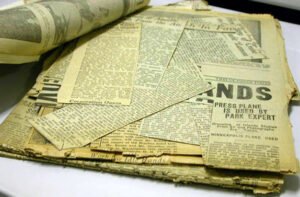The importance of preserving magazines and newspaper cuttings
Heramba Nath
Preserving magazines and newspaper cuttings is a meaningful and essential practice that holds significant value for individuals and society alike. These materials serve as invaluable windows into the past, offering unique insights into historical events, cultural movements, societal changes, and everyday life across different time periods. By safeguarding such documents, we ensure that the knowledge, memories, and perspectives contained within them remain accessible for future generations.
Magazines and newspaper cuttings are primary sources that provide firsthand accounts of events, offering an authentic view of how situations unfolded and were perceived at the time. For example, newspaper reports from the time of World War II or India’s independence offer detailed narratives and societal reactions that no textbook can fully replicate. These preserved materials allow people to connect with history in a deeply personal and immersive way.
Beyond historical value, they are immensely useful for research and education. Scholars, students, and historians often rely on old magazines and newspapers to explore a wide range of subjects — from politics and economics to fashion and public opinion. A student researching the evolution of environmental awareness in society can find a wealth of information in articles and editorials published over decades. Similarly, a scholar examining advertising trends can trace changes in marketing strategies through magazine spreads across the years.
Preserved publications also carry strong sentimental value. They often commemorate personal milestones and cherished memories. A family might keep a newspaper clipping of a wedding announcement or a school achievement. A magazine featuring a loved one or a long-admired celebrity can become a treasured keepsake. These items reflect individual histories as much as they do collective ones, making their preservation all the more worthwhile.
To ensure the longevity of these delicate materials, proper handling and storage are crucial. Magazines and newspapers are typically printed on low-quality paper that deteriorates over time. They must be handled with clean hands and stored flat, without folding or crumpling. Acid-free folders, envelopes, and boxes are ideal for storage as they help prevent yellowing and brittleness. Storage conditions also matter — avoid exposure to direct sunlight, humidity, and extreme temperatures, all of which can accelerate deterioration.
An increasingly popular method of preservation is digitisation. This process involves scanning or photographing the materials and saving them in digital formats. Digitised versions not only prevent physical damage but also make these documents easier to organise, search, and share. Libraries, archives, and even individuals can use digital technology to protect valuable records while making them more widely accessible.
Preserving magazines and newspaper cuttings is, therefore, not merely about holding onto paper. It is about preserving the thoughts, emotions, knowledge, and events of past times. These preserved materials offer a rich tapestry of human experience that helps us understand how we arrived at where we are today.
In the final analysis, the preservation of magazines and newspaper cuttings is essential for maintaining a meaningful connection to our past. Whether used for historical research, educational purposes, or personal reflection, these materials carry a richness that cannot be recreated once lost. Through conscious preservation efforts, we contribute to a broader cultural memory and ensure that future generations can learn from and appreciate the legacies we choose to protect.
Ultimately, this task demands care, effort, and foresight — but the rewards are invaluable. By recognising the significance of magazines and newspaper cuttings and taking steps to preserve them, we honour our history, enrich our present, and safeguard knowledge and memories for the years to come.

